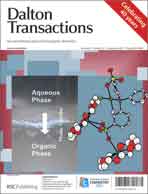C–X bond formation and cleavage in the reactions of the ditungsten hydride complex [W2(η5-C5H5)2(H)(μ-PCy2)(CO)2] with small molecules having multiple C–X bonds (X = C, N, O)†
Abstract
Two molecules of C2(CO2Me)2 or ![[double bond, length as m-dash]](https://www.rsc.org/images/entities/char_e001.gif) C(CO2Me)C(CO2Me)
C(CO2Me)C(CO2Me)![[double bond, length as m-dash]](https://www.rsc.org/images/entities/char_e001.gif) CH(CO2Me)}(μ-PCy2)(CO)2] (Cp = η5-C5H5), diazadienyl-[W2Cp2{μ-κ,η:κ,η-C{CHN(4-MeO–C6H4)}N(4-MeO–C6H4)}(μ-PCy2)(CO)2] or aminocarbyne-bridged derivatives [W2Cp2{μ-CNH(2,6-Me2C6H3)}(μ-PCy2){CN(2,6-Me2C6H3)}(CO)]. In contrast, its reaction with excess (4-Me–C6H4)C(O)H gave the C–O bond cleavage products [W2Cp2{CH2(4-Me–C6H4)}(O)(μ-PCy2)(CO)2] and [W2Cp2{μ-η:η,κ-C(O)CH2(4-Me–C6H4)}(O)(μ-PCy2)(CO)].
CH(CO2Me)}(μ-PCy2)(CO)2] (Cp = η5-C5H5), diazadienyl-[W2Cp2{μ-κ,η:κ,η-C{CHN(4-MeO–C6H4)}N(4-MeO–C6H4)}(μ-PCy2)(CO)2] or aminocarbyne-bridged derivatives [W2Cp2{μ-CNH(2,6-Me2C6H3)}(μ-PCy2){CN(2,6-Me2C6H3)}(CO)]. In contrast, its reaction with excess (4-Me–C6H4)C(O)H gave the C–O bond cleavage products [W2Cp2{CH2(4-Me–C6H4)}(O)(μ-PCy2)(CO)2] and [W2Cp2{μ-η:η,κ-C(O)CH2(4-Me–C6H4)}(O)(μ-PCy2)(CO)].
![Graphical abstract: C–X bond formation and cleavage in the reactions of the ditungsten hydride complex [W2(η5-C5H5)2(H)(μ-PCy2)(CO)2] with small molecules having multiple C–X bonds (X = C, N, O)](/en/Image/Get?imageInfo.ImageType=GA&imageInfo.ImageIdentifier.ManuscriptID=C1DT10871A&imageInfo.ImageIdentifier.Year=2011)

 Please wait while we load your content...
Please wait while we load your content...